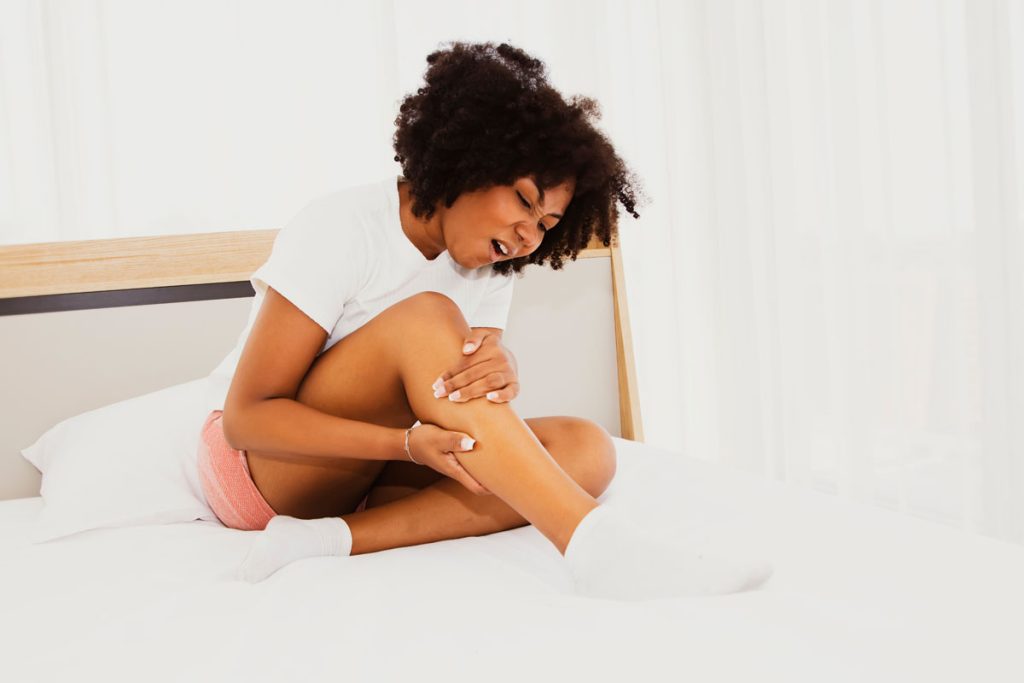You’re in bed, and your calf starts cramping. Or you’re standing in line at the grocery checkout, and your legs start feeling heavy like you’re slogging through mud, but you’re standing still. Or maybe you’re sitting at your desk when you feel sharp pins and needles in your calves. No matter where or when, if leg pain is impacting your life, it may be related to being in menopause. Leg pain is one of the many symptoms of the menopause transition, and there are 5 practical steps you can take to reduce leg cramps, aches, and pains.
Menopause leg pain
Are you getting concerned as you realize you’re experiencing leg pain more and more often –during the day and in the middle of the night? It’s bad enough to distract you during the day, but what can you do about the leg pain or cramps that jolt you awake in the middle of the night?
The pain may even radiate to the arch of your foot or your hip.
Leg pain is one of the dozens of symptoms women experience that could be a sign of menopause.
Lucky you – from menstrual cramps to leg cramps and joint and muscle pain? Oh, and don’t forget hot flashes, sleepless nights, and weight gain. When will it end?
Menopause is like a marathon, with the average woman spending between 7 and 10 years transitioning from perimenopause, to menopause, and eventually post-menopause.
Can hormonal imbalance cause leg pain?
If you’re a woman of menopausal age (typically between 45 and 55), the cause of those tingling, pricky sensations in your legs could be related to the fluctuations of hormone levels that cause menopause.
Like so many other menopause symptoms a drop in estrogen can be one of the causes of leg pain
The veins in your legs do not have a muscular layer and use valves to keep blood flowing. Decreasing estrogen levels during menopause can cause these valves and the walls of your blood vessels to weaken and change the circulation to your legs, which can lead to varicose veins.
Hormones and magnesium
That drop in estrogen can also affect your body’s ability to absorb magnesium, and magnesium deficiency has been linked to muscle cramps.
Interestingly, stress can also cause a magnesium deficiency. So, if you’re stressed about being in menopause or middle-aged life, your body could also be telling you through the leg cramps and joint and muscle pain, that it needs more magnesium.
It also may be telling you to slow down and relieve some of your stress.
You’re not stuck with menopause-related leg cramps forever, and there are things you can do to decrease the pain and make menopause symptoms more manageable. And of course, given the many potential reasons you may have leg pain, talking with your doctor is a good first step.
Ready to make a change for the better?
The different types of menopause leg pain
First, how would you describe your pain?
Do you..
- Feel a cramp?
- Feel achy?
- Get swollen ankles?
- Have tingly legs?
- Have restless legs?
- Have pain in your hip area?
- Have feet that are very hot (and very cold)?
Women have described symptoms that range from minor to excruciating during the menopause journey.
And the leg pain and discomfort often strikes at night!
Understanding the type of pain you’re experiencing can help you reduce it.
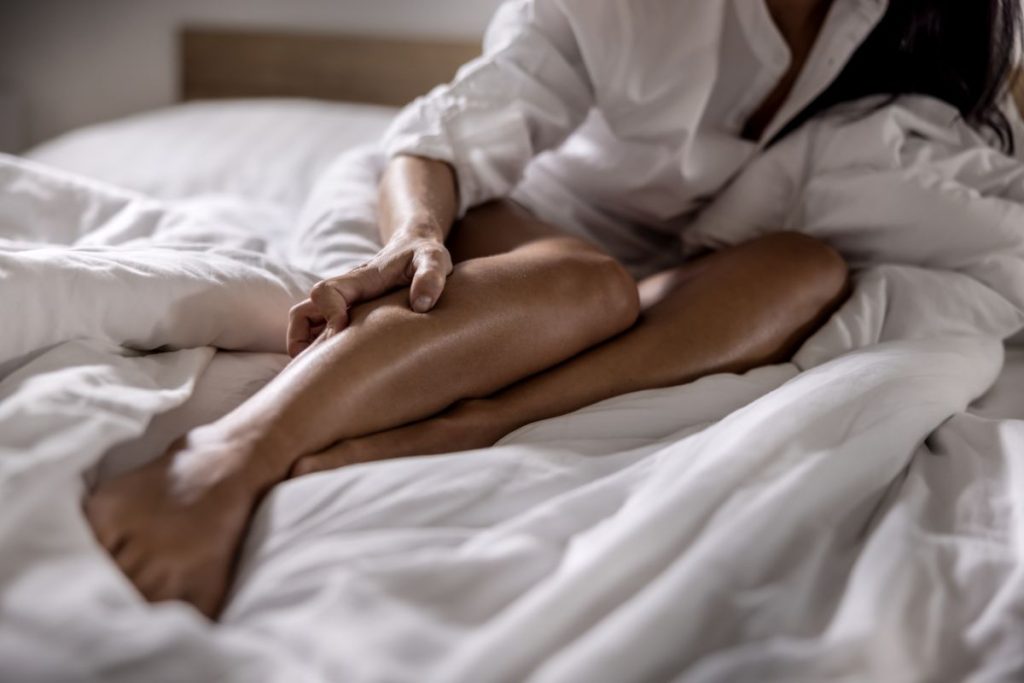
Leg pain at night
Sleep can be elusive during the menopause transition. Leg pain can only make it even harder to sleep.
Perhaps you’ve been jolted awake by a cramp.
These sudden and intense pains in the arch of your foot or leg, which some people call a “Charley Horse,” can be managed by quickly stretching or massaging the affected area. It may be painful, so tread lightly as you try to relax the muscles.
You can also try standing to force the spasm to stop.
A heating pad can also help with a stubborn cramp or persistent leg pain.
Once the pain is gone, think about how often it happens.
Consistent cramps can be a sign of a magnesium deficiency which you can solve with supplements or dietary changes.
Nighttime leg pain could be restless leg syndrome
If you’re awoken in the middle of the night by throbbing leg pain, take note of the type of pain you feel.
Is it more than just a cramp or sudden pain?
Do you have a highly restless night’s sleep, waking you up with uncomfortable, throbbing, crawling or shaking sensations in your legs?
This could be restless leg syndrome (RLS). It’s another type of leg pain reported by women during menopause.
RLS is a disorder of the nervous system, which impacts leg muscles.
Restless legs can exacerbate menopause symptoms because they can make it difficult to sleep, which is already elusive if you’re in the menopause transition.
Stress and anxiety can also make RLS worse.
Hip and leg pain from greater trochanteric pain syndrome
Some women also experience leg pain on the outside of their hip. The pain may get worse with activities like standing, walking, or running.
This may be a symptom of gluteal tendinopathy, which is the cause of what’s medically known as greater trochanteric pain syndrome (GTPS). It’s essentially lateral hip pain (pain on the side of the hip). Often the area is tender and painful when you sit with your legs crossed.
The pain is seen more commonly in females between the ages of 40 and 60 and it can be debilitating especially in post-menopausal women.
There’s some evidence in clinical studies that hormone changes after menopause may negatively impact RLS.
Consider this – in pre-menopausal women, the chance of getting lower limb tendinopathy is lower than that of men. But, in post-menopausal women, the rates increase.
A study in Australia of postmenopausal women with GTPS evaluated the effectiveness of menopausal hormone therapy and exercise therapy to reduce this tendon pain.
Other treatments, not part of this study, included shockwave therapy, home training, corticosteroid injections, surgery, and exercise programs.
The study found menopausal hormone therapy when combined with exercise may reduce the of the hip pain from GTPS.
Research is ongoing. A review of several studies, including the Australian one above, found a lack of studies and difficulty in consensus among authors for the best treatment protocol. The review concluded that conservative treatment should be the first choice along with specific exercises, tendon management, and gradual load increase.
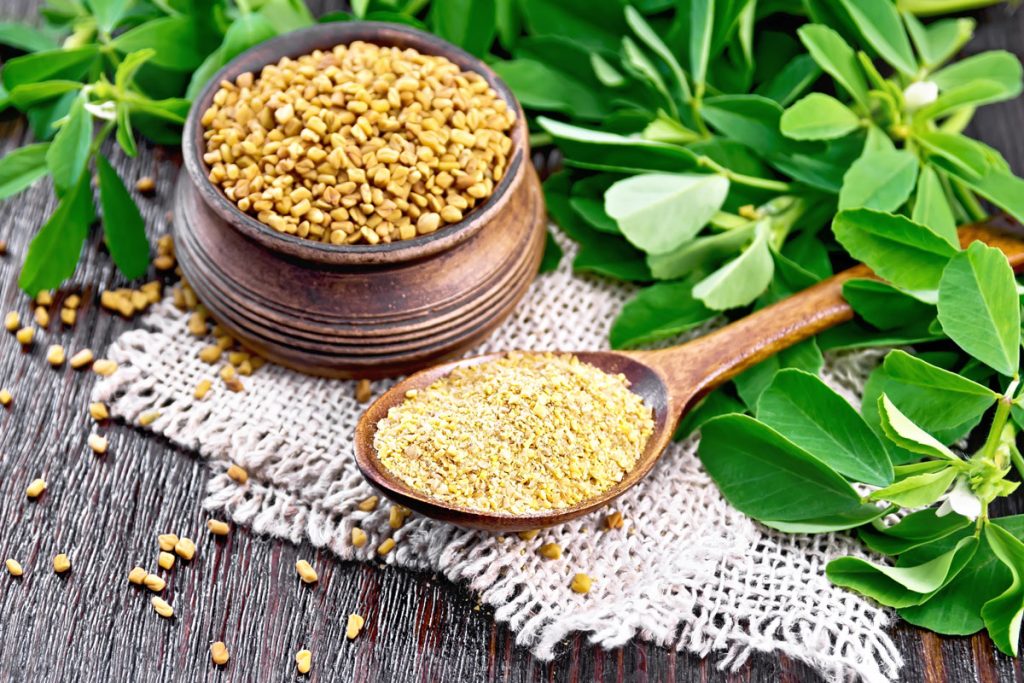
5 ways to decrease your menopause leg pain
Managing menopause symptoms often comes down to maintaining a healthy lifestyle. It’s a powerful tool to optimize well-being.
It also plays a big role in menopause-related leg cramps and making them better or worse.
Here are a few easy shifts that may help decrease your menopause-related leg cramps.
1. Watch your weight with a well-balanced diet
We understand it’s easier said than done. Women told us weight gain was their number one struggle in a pausitive health survey. Even just a few extra pounds can contribute to menopause-related leg cramps.
Create attainable goals with your weight. Focus on food and exercise.
Eat a balanced diet, with foods that can improve all your menopause symptoms. Include plenty of fresh fruits and green leafy vegetables, lean protein, whole grains, nuts and seeds.
Remember, a magnesium deficiency can be associated with leg pain. So, add high-magnesium foods, like green leafy vegetables, almonds, seeds, fish, avocados, meat and dairy.
Omega-3s and vitamin C help support blood vessel walls and circulation, so supplement your diet with foods rich in Omega-3s like oily fish, flax oil, walnuts and chia seeds, and vitamin C rich foods like citrus, berries, green leafy vegetables and parsley.
Want to know other foods that can help you manage menopause so it doesn’t control you? Get the pausitive health grocery list.
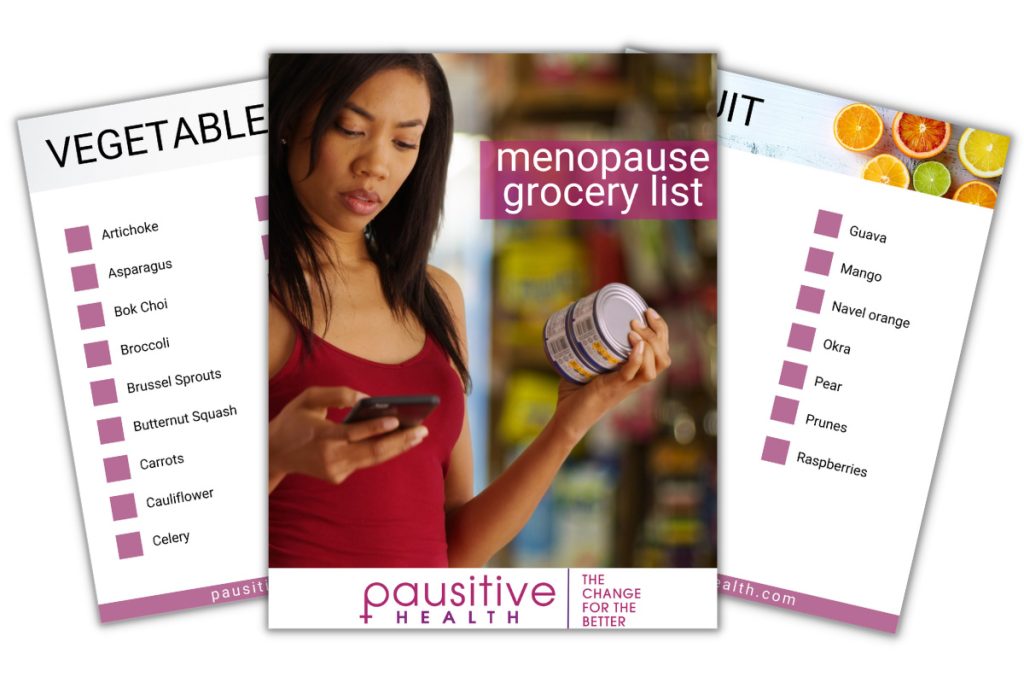
Make A Change For The Better!
This menopause grocery list contains a combination of foods specifically selected to help you feel better today and even better in the future.
"*" indicates required fields
2. Supplements for leg pain
You may consider adding supplements if you don’t get enough essential vitamins through food.
Some women find that adding magnesium, Omega-3, vitamin C, or vitamin D helps decrease their menopause-related leg cramps.
There are additional vitamins and minerals that might be helpful if you are deficient, including vitamins B1 (thiamine) and B12, and potassium (may be seen in those on diuretics).
In a small study, vitamin E (Tocopherol) helped patients who had frequent and severe leg cramps at night. Nearly all of the patients received relief with 100 I.U. of vitamin e in the form of d, alpha-tocopheryl acetate, when taking three times a day before meals. Two of the patients had restless leg syndrome, and the others had leg cramps.
Also, talk to your doctor before you add supplements to your diet. They can interact with each other as well as medications you may be taking, in addition to having potential side effects.
3. Move around
Sitting or standing for long periods can cause leg cramps; regularly change between sitting and standing. If you work in an office or at home, get up and move.
An exercise watch is a good tool to remind yourself to get up and move. They can be set to send you periodic alerts when it’s time to move (recommended every 30 – 60 minutes).
These menopause exercise videos are another great way to improve circulation and can help decrease menopause-related leg cramps.
Also, stretch your legs to increase flexibility and relieve tightness
4. Manage stress
So many menopause symptoms relate back to stress. It can cause health problems long-term whether you’re in menopause or not, but during menopause when your hormones are in flux, it can cause a snowball effect.
If you’re stressed, your legs may be more restless if you have RLS, and if you’re struggling with RLS then you may not sleep.
We often say we want to reduce stress, but following through with that action consistently is difficult.
You can try yoga, meditation, gratitude, or even improve your sleep hygiene routine so you have time to unwind each day and prepare for sleep.
Don’t stress about being stressed, but take steps to reduce it in the long-term before it impacts your health and menopause journey in ways that can’t be reversed.
5. Drink water
It seems so simple, but drinking water can help decrease leg pain by ensuring you’re hydrated.
Dehydration can lead to menopause-related leg cramps.
So, how much do you need? The amount can differ depending on several factors. including medications, physical activity level, how hot the weather is, and preexisting kidney disease or congestive heart failure.
Here’s a hydration calculator that can provide an idea of how much water you need.
And remember, alcohol and caffeinated beverages like coffee, tea and soda can have a diuretic effect, further worsening dehydration.
6. Elevate your legs
This is one of the easiest ways to manage swelling and discomfort, to help drain the fluid that may be pooling in your legs and help improve your circulation. Be sure your legs are raised slightly above your heart, to help any pooling fluid move back toward your heart and circulate through the rest of your body.
7. Consider using fenugreek and horse chestnut
For centuries, herbal medicine practitioners have used fenugreek and horse chestnut to decrease leg pain and other symptoms of menopause. And modern medicine is starting to catch up, studying the success of both. Supplementing with extract of fenugreek has been shown to regulate various hormones in postmenopausal women and significantly decrease vasomotor effects (e.g., hot flashes or flushes, night sweats) and leg pain.
Horse chestnut seed extract may help with chronic venous insufficiency (CVI) and poor blood flow in the veins of the legs, which can lead to leg pain, swelling, itchiness, and other symptoms. Results from one study suggested that horse chestnut seed extract could be as effective as wearing compression stockings.
Before taking any natural supplements like these, talk to an herbal medicine practitioner and/or your primary care provider.
You’ll want to discuss the benefits and risks of taking fenugreek or horse chestnuts to decrease leg pain related to menopause and learn about any potential drug interactions with medications you’re already taking.
Make changes in your lifestyle
You have the power to decrease and even eliminate menopause-related leg cramps from your life. If you’re experiencing troublesome menopause leg pain, cramps, swelling or aching, put together a plan to change your diet and your lifestyle.
If your doctor recommends hormone therapy, know that it’s not your only option. Lifestyle plays a critical role in how you feel during the menopause journey, and leg pain is a symptom that you can control without the use of HT.
It’s critical not to keep all your thoughts and feelings to yourself. Talk, with your doctor, your naturopath, your nutritionist and other women experiencing similar symptoms, to find the solution that works best for you.
Speers CJ, Bhogal GS. Greater trochanteric pain syndrome: a review of diagnosis and management in general practice. Br J Gen Pract. 2017 Oct;67(663):479-480. doi: 10.3399/bjgp17X693041. PMID: 28963433; PMCID: PMC5604828.
Ganderton C, Semciw A, Cook J, Pizzari T. Does menopausal hormone therapy (MHT), exercise or a combination of both, improve pain and function in post-menopausal women with greater trochanteric pain syndrome (GTPS)? A randomised controlled trial. BMC Womens Health. 2016 Jun 16;16:32. doi: 10.1186/s12905-016-0311-9. PMID: 27312538; PMCID: PMC4910216.
Cowan RM, Ganderton CL, Cook J, Semciw AI, Long DM, Pizzari T. Does Menopausal Hormone Therapy, Exercise, or Both Improve Pain and Function in Postmenopausal Women With Greater Trochanteric Pain Syndrome? A 2 × 2 Factorial Randomized Clinical Trial. Am J Sports Med. 2022 Feb;50(2):515-525. doi: 10.1177/03635465211061142. Epub 2021 Dec 13. PMID: 34898293.
Kamila Maria Sousa de Castro, Erislane Nátalia de Oliveira Silva. Evaluation and physiotherapeutic management of the greater major trochanteric pain syndrome: integrative review. BrJP. São Paulo, 2020 apr-jun;3(2):170-6. doi: 10.5935/2595-0118.20200031.
Ayres S Jr, Mihan R. Leg cramps (systremma0 and “restless legs” syndrome. Response to vitamin E (tocopherol). Calif Med. 1969 Aug;111(2):87-91. PMID: 5346435; PMCID: PMC1503587.
15 of the best vitamins for leg cramps and food sources | MedicalNewsToday
Hydration calculator | Mindful by Sodexo
Fenugreek | National Center for Complementary and Integrative Health
Vasomotor | ScienceDirect®
Horse Chestnut | National Center for Complementary and Integrative Health
You may also like…
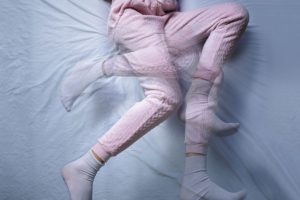
Why Women+ Are Prone To Restless Leg Syndrome (RLS) And How To Treat It
Do your legs move uncontrollably at night? Learn why Restless Leg Syndrome (RLS), is more common in women and how to treat it.

Which Herbal Remedies Offer Relief From Hot Flashes And Other Menopause Symptoms?
Can herbal remedies help menopause symptoms like hot flashes? Get the latest science, risks, and reported health benefits.

Foods For Menopause: 9 Best Foods To Help Menopause
Did you know you can manage your menopause symptoms with food? Learn the 10 best foods packed with the necessary nutrients to feel better.

